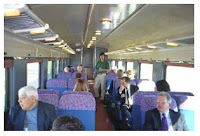 |
| Henderson Pvblic Library opened its doors to the public August 1, 1904 |
This is the second post in a series of photo essays celebrating Downtown Henderson
It was during a game of golf during the early 1900s that a commitment of funding to build the
Henderson Pvblic Libary was made by well-known philanthropist
Andrew Carnegie. As Carnegie and
Edward Jonas, publisher of the Henderson Journal, shared their game of golf, Jonas also shared his vision and desire to see a public library building erected in Henderson. Carnegie pledged funding for the original structure (photo above shows the now unused front entrance). His funding promise came with the stipulation that the community would secure an appropriate lot and enact a tax to cover the ongoing operation costs of the library. In 1902, after campaigning for the project for years, Jonas convinced the local government to the purchase the land, and the library tax became part of Henderson County's law.
 Classical Architecture
Classical Architecture
From 1890 - 1940, a Renaissance of the Classical architectural style took place in the United States. Henderson Pvblic Library was designed in this Classical theme.The classical columns, domes and pediments reflect the
Vignola (Italian architect) style of this period.
The "V" in PVBLIC

Like many other libraries built during the same period, the "V" engraved in PVBLIC represents the letter "U." Though not an exact answer, it is believed that the architects of this time used the Classic Roman alphabet, as they were generally taught both Greek and Latin. In the Classic Roman alphabet used up until 900 A.D., the "V" was used for either U or V. The Romans had adopted the Greek letter "Y," but dropped the bottom stroke.
Susan Towles, first head librarian
Just prior to the opening of the library in August 1904, Susan Towles was hired as the first head librarian. With a library of only 500 books at this location and 100 books at another for the African-American population, Towles began her 45-year career. Her successor, Sarah Winstead, transitioned with the first major renovation in 1960. During this first of three other renovations from 1960 - 1978 the adult non-fiction and children's area were expanded.

In 1979-80, after the appointment of director Donald Wathen, the addition of 10, 283 square feet that made space for the adult and reference departments was completed. The addition for the children's department was finished in 2000.
2002 started a period of restoration and preservation for the library. The rotunda murals were restored by a team of experts that found surprising discoveries as they removed dirt and paint to reveal the beautiful laurel leaf borders on the murals' frames and the names of classic authors between the paintings. In 2003, new copper roofing replaced the old rotunda covering, and the stained glass rotunda skylight was removed, cleaned and re-leaded.

The restoration and preservation project completed in May 2004 with the refinishing of woodwork and light fixtures. It was then time to celebrate the libraries 100th centennial anniversary later that year in August 2004.
My personal
remembrance
----------------------------------
As a young married college student in the early 70s, I spent many hours researching and studying in the library. At that time, no additions had been made to the original facility. In 1986, after the birth of my first daughter, I began to attend a
La Leche League group for mothers in a small meeting area behind what was then very close quarters in the children's department. I can remember the excitement of my children taking their books to the desk of the children's librarian at the time, Ms. Glenda. With her lovely smile, she greeted the children and asked them short questions or commented on their choice of reading. She would then take her well-inked date stamp in hand and imprint the due back date on the small index size cards that fit just right in the half envelope type pocket found inside the cover of each book or magazine . Before she'd carefully slip each card in its proper place, she checked to make sure the dates on the cards were readable. As she tucked them in, she'd remind my children of the date to return.
As my children grew a bit older, the 1979-80, 10, 283 square feet addition brought about a stir of excitement in them. They saw more room for books and extra opportunities to hide in the long rows of shelves from each other or me. As a family, we enjoyed many visits together and often brought friends with us to the library. I will always be thankful that my children learned about and used the Dewey decimal system, as well as the card catalog. Many fond memories of this powerhouse of learning are etched in our minds. These unforgettable moments are ones to cherish and pass on to our grandchildren so that they may pass them on too.























